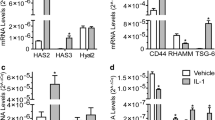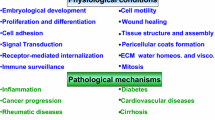Summary
Cartilage from patients with rheumatoid arthritis and from animals with antigen-induced arthritis is frequently contaminated with complement-containing immune complexes. A possible role for complement activation in cartilage degradation was modeled in vitro by exposing cultured bovine chondrocytes to homologous serum, and determining cytotoxicity by monitoring the release of intracellular 51Cr. Complement activation was found to be cytotoxic, having maximal effect at 20–30% serum by 18 h. Serum toxicity was ablated by heat (50°C, 20 min) or methylamine treatment but not by EGTA, suggesting that in these experiments activation occurred by the alternate route. The implications of the results are discussed in relation to ultrastructural evidence for the involvement of complement in the pathogenesis of cartilage degradation in inflammatory arthritis.
Similar content being viewed by others
References
Mainardi CL (1987) Biochemical mechanisms of articular destruction. Rheum Dis Clin 13:215–233
Poole AR (1990) Enzymatic degradation: cartilage destruction. In: Brandt KD (ed) Cartilage changes in osteoarthritis. CIBA-Geigy/Indianapolis University School of Medicine, Indianapolis, pp 63–72
Mitchell N, Shepard N (1970) The ultrastructure of articular cartilage in rheumatoid arthritis. J Bone Joint Surg 52A:1405–1423
Dumonde DC, Glynn LE (1962) The production of arthritis in rabbits by an immunological reaction to fibrin. Br J Exp Pathol 43:373–383
Cooke TDV (1988) Antigen-induced arthritis, polyarthritis, and tenosynovitis. In: Greenwald RA, Diamond HS (eds) Handbook of animal models for the rheumatic diseases, vol. 1. CRC Press, Press, Boca Raton, Florida, pp 53–78
Sumi M, Maeda M, Cooke TDV (1986) Deleterious interactions of immune complexes with tibial cartilage of antigen-induced arthritic rabbits II. Chondrocyte degradation. Clin Orthop 212:260–274
Cooke TDV, Sumi M, Maeda M (1985) Deleterious interactions of immune complexes in cartilage of experimental immune arthritis 1. The erosion of pannus-free hyaline cartilage. Clin Orthop 183:235–245
McCarthy D, Goddard GH, Pell BK, Holborow EJ (1981) Intrinsically stable IgG aggregates. J Immunol Methods 41:63–74
Saura R, Uno K, Satsuma S, Kurz EU, Scudamore RA, Cooke TDV (1993) Mechanisms of cartilage destruction in inflammatory arthritis. Interactions between immunoglobulin and chondrocytes. J Reumatol 20:336–343
Cooke D, Saura R, Uno K, Scudamore A (1991) Interactions of immunoglobulins and chondrocytes. J Rheumatol 18 [Suppl 27]:114–116
Saura R, Cooke TDV, Scudamore RA, Satsuma S (1991) Cartilage destruction in rheumatoid arthritis: cytotoxicity of immunoglobulins and complement against chondrocytes. Trans Orthop Res Soc 16:337
Cooke TDV, Hurd ER, Jasin HE (1975) Identification of immunoglobulins and complement in rheumatoid articular collagenous tissues. Arthritis Rheum 18:541–551
Vetto AA, Mannik M, Zatarain-Rios E, Wener MH (1990) Immune deposits in articular cartilage of patients with rheumatoid arthritis have a granular pattern not seen in osteoarthritis. Rheumatol Int 10:13–19
Ohno O, Cooke TDV (1978) Electromicroscopic morphology of immunoglobulin aggregates and their interactions in rheumatoid articular collagenous tissues. Arthritis Rheum 21:516–527
Kuettner KE, Pauli BU, Gall G, Memoli VA, Schenk RK (1982) Synthesis of cartilage matrix by mammalian chondrocytes in vitro. I. Isolation, culture characteristics, and morphology. J Cell Biol 93:743–750
Glowacki J, Trepman E, Folkman J (1983) Cell shape and phenotypic expression in chondrocytes. Proc Soc Exp Biol Med 172:93–98
Watt FM (1988) Effect of seeding density on stability of the differentiated phenotype of pig articular chondrocytes in culture. J Cell Sci 89:373–378
Pang ASD, Aston WP (1977) Alternative complement pathway in bovine serum: lysis of human erythrocytes. Am J Vet Res 38:355–359
Rapp HJ, Borsos T (1970) Reagents commonly used in complement research. In: Molecular basis of complement action. Appleton Centuary Crofts, New York, pp 75–109
Pang ASD, Aston WP (1978) The alternative complement pathway in bovine serum: the isolation of a serum protein with factor B activity. Immunochemistry 15:529–534
Mhatre A, Aston WP (1987) A simple hemolytic assay for bovine complement component C3. Vet Immunol 15:239–251
Sacks T, Moldow CF, Craddock PR, Bowers TK, Jacob HS (1978) Oxygen radicals mediated endothelial cell damage by complement-stimulated granulocytes. An in vitro model of immune vascular damage. J Clin Invest 61:1161–1167
Simon RH, Scoggin CH, Patterson D (1981) Hydrogen peroxide causes the fatal damage to human fibroblasts exposed to oxygen radicals. J Biol Chem 256:7181–7186
Weiss SJ, Young J, LoBuglio AF, Slivka A (1981) Role of hydrogen peroxide in neutrophil-mediated destruction of cultured endothelial cells. J Clin Invest 68:714–721
Saura R, Cooke TDV, Scudamore RA (1990) Matrix-degrading activity of chondrocytes stimulated by heat-aggregated IgG (abstract) Arthritis Rheum 33 [Suppl 5]:R40
Jacobs DB, Pipho C (1983) Use of propidium iodide staining and flow cytometry to measure antibody-mediated cytotoxicity: resolution of complement-sensitive and resistant target cells. J Immunol Methods 62:101–108
Muller-Eberhard HJ (1986) The membrane attack complex of complement. Ann Rev Immunol 4:503–528
Burger R, Hadding U, Schorlemmer HU, Brade V, Bitter-Suermann D (1975) Dextran sulfate: a synthetic activator of C3 via the alternative pathway. I. Influence of molecular size and degree of sulphation on the activation potency. Immunology 29: 549–554
Ruddy S, Austen KF (1970) The complement system in rheumatoid synovitis: 1. an analysis of complement component activities in rheumatoid synovial fluids. Arthritis Rheum 13: 713–723
Rodman WS, Williams RC, Bilka PJ, Muller-Eberhard HJ (1967) Immunofluorescent localization of the third and the fourth component of complement in synovial tissue from patients with rheumatoid arthritis. J Lab Clin Med 69:141–149
Partsch G, Bauer K, Broll H, Petera P, Dunky A, Meretey K (1991) Complement C3 cleavage product in synovial fluids detected by immunofixation. Z Rheumatol 50:82–85
Sanders ME, Kopicky JA, Wigley FM, Shin ML, Frank MM, Joiner KA (1986) Membrane attack comples of complement in rheumatoid synovial tissue demonstrated by immunofluorescent microscopy. J Rheumatol 13:1028–1034
Cooke TDV, Scudamore RA (1989) Studies in the pathogenesis of rheumatoid arthritis. 2: Antigen/antibody reactions with avascular joint tissues. Br J Rheumatol 28:333–340
Ostensen M, Stiansen R, Hetland G, Garred P (1991) Complement and complement receptors in human articular chondrocytes. In: Kuettner KE, Schleyerbach R, Peyron JG, Haskell VC (eds) Articular cartilage and osteoarthritis. Raven Press, New York p 706
Pettipher ER, Henderson B, Hardingham T, Ratcliffe A (1989) Cartilage proteoglycan depletion in acute and chronic antigen-induced arthritis. Arthritis Rheum 32:601–607
Harada T, Scudamore RA, Cooke TDV, Smith JT (1992) Deleterious interactions of immune complexes with cartilage in inflammatory arthritis. IV. Role of polymorphonuclear neutrophils. Eur J Exp Musculoskel Res 1:19–24
Hembry RM (1990) Rabbit models of arthritis: immunolocalization of metalloproteases and TIMP in synovium and cartilage. In: Knight GC, Wayman P (eds) The Stangeways Research Laboratory Cambridge. Annual Report 1990. Stangeways Research Laboratory, Cambridge, pp 26–30
Henderson B, Pettipher ER, Murphy G (1990) Metallo-proteinases and cartilage proteoglycan depletion in chronic arthritis. Arthritis Rheum 33:241–246
Iwasaki Y, Matsubara T, Hirohata K (1988) A mechanism of cartilage destruction in immunologically-mediated inflammation: increased superoxide anion release from chondrocytes in response to interleukin-1 and interferons. Orthop Trans 12:438
Saura R, Cooke TDV, Scudamore RA (1991) Superoxide generation by chondrocytes following stimulation by heat-aggregated IgG. Orthop Trans 15:177–178
Author information
Authors and Affiliations
Rights and permissions
About this article
Cite this article
Satsuma, S., Scudamore, R.A., Cooke, T.D.V. et al. Toxicity of complement for chondrocytes. A possible source of cartilage degradation in inflammatory arthritis. Rheumatol Int 13, 71–75 (1993). https://doi.org/10.1007/BF00307737
Received:
Accepted:
Issue Date:
DOI: https://doi.org/10.1007/BF00307737




